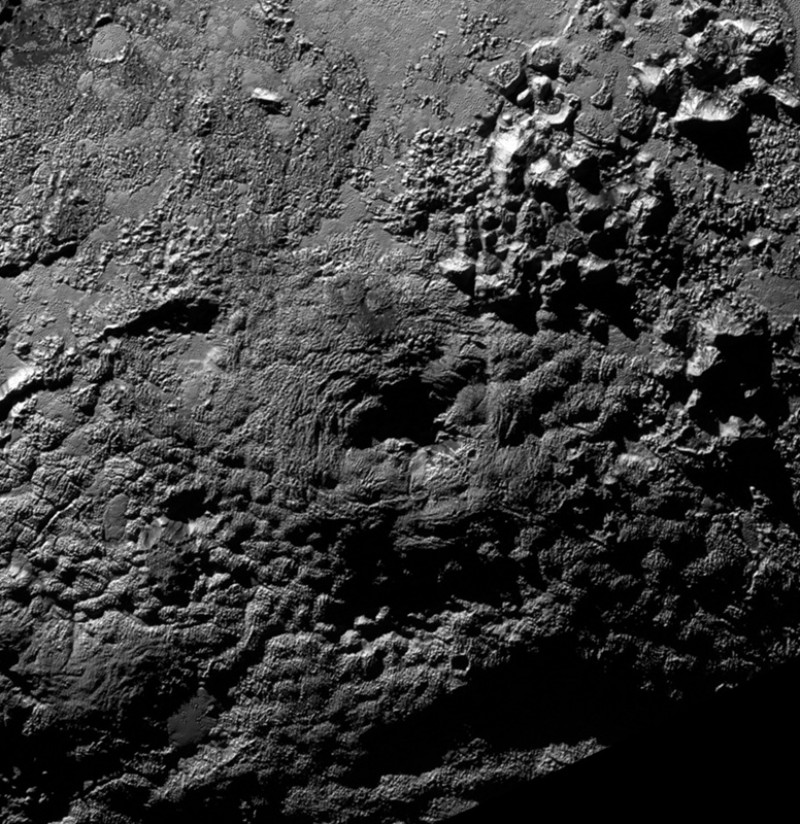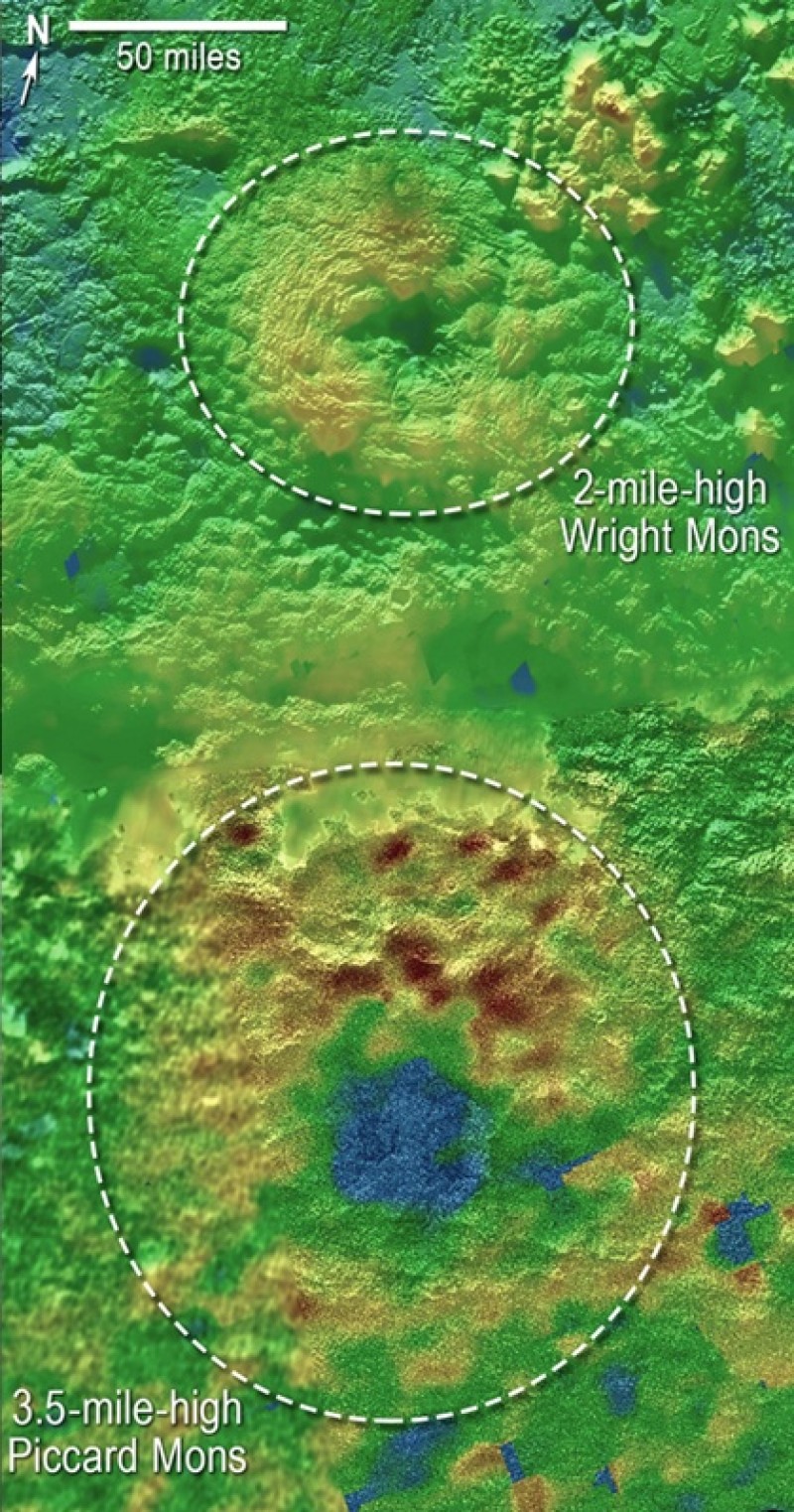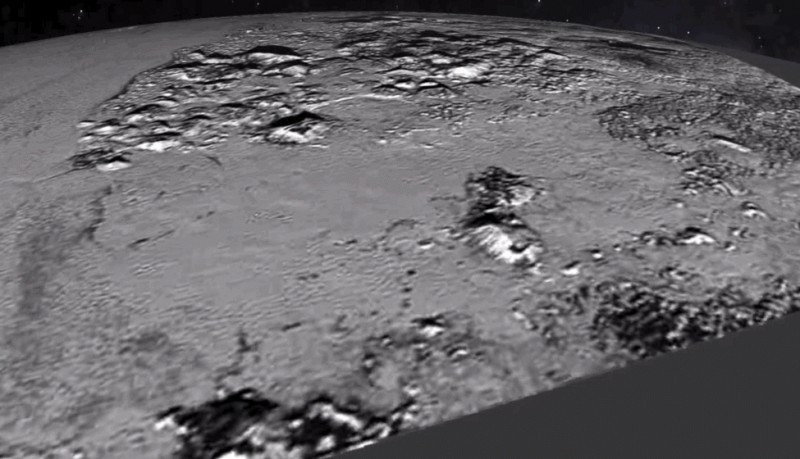 |
|
The informally named feature Wright Mons, located south of Sputnik Planum on Pluto, is an unusual feature that’s about 100 miles (160 kilometers) wide and 13,000 feet (4km) high. It displays a summit depression (visible in the center of the image) that's approximately 35 miles (56km) across, with a distinctive hummocky texture on its sides. The rim of the summit depression also shows concentric fracturing. New Horizons scientists believe that this mountain and another, Piccard Mons, could have been formed by the "cryovolcanic" eruption of ices from beneath Pluto's surface.
NASA/Johns Hopkins University Applied Physics Laboratory/Southwest Research Institute
|
From possible ice volcanoes to twirling moons, NASA’s New Horizons science team is discussing more than 50 exciting discoveries about Pluto at this week’s 47th Annual Meeting of the American Astronomical Society’s Division for Planetary Sciences in National Harbor, Maryland.
“The New Horizons mission has taken what we thought we knew about Pluto and turned it upside down,” said Jim Green from NASA Headquarters in Washington, D.C. “It’s why we explore — to satisfy our innate curiosity and answer deeper questions about how we got here and what lies beyond the next horizon.”
For one such discovery, New Horizons geologists combined images of Pluto’s surface to make 3-D maps that indicate two of Pluto’s most distinctive mountains could be cryovolcanoes — ice volcanoes that may have been active in the recent geological past.
“It’s hard to imagine how rapidly our view of Pluto and its moons are evolving as new data stream in each week. As the discoveries pour in from those data, Pluto is becoming a star of the solar system,” said Alan Stern of the Southwest Research Institute in Boulder, Colorado. “Moreover, I’d wager that for most planetary scientists any one or two of our latest major findings on one world would be considered astounding. To have them all is simply incredible.”
The two cryovolcano candidates are large features measuring tens of miles or kilometers across and several miles or kilometers high.
“These are big mountains with a large hole in their summit, and on Earth that generally means one thing — a volcano,” said Oliver White from NASA’s Ames Research Center in Moffett Field, California. “If they are volcanic, then the summit depression would likely have formed via collapse as material is erupted from underneath. The strange hummocky texture of the mountain flanks may represent volcanic flows of some sort that have traveled down from the summit region and onto the plains beyond, but why they are hummocky and what they are made of, we don’t yet know.”
While their appearance is similar to volcanoes on Earth that spew molten rock, ice volcanoes on Pluto are expected to emit a somewhat melted slurry of substances such as water ice, nitrogen, ammonia, or methane. If Pluto proves to have volcanoes, it will provide an important new clue to its geologic and atmospheric evolution.
“After all, nothing like this has been seen in the deep outer solar system,” said Jeffrey Moore from Ames.
Pluto’s long history of geologic activity
Pluto’s surface varies in age -- from ancient, to intermediate, to relatively young --according to another new finding from New Horizons.
To determine the age of a surface area of the planet, scientists count crater impacts. The more crater impacts, the older the region likely is. Crater counts of surface areas on Pluto indicate that it has surface regions dating to just after the formation of the planets of our solar system, about 4 billion years ago.
But there also is a vast area that was, in geological terms, born yesterday — meaning it may have formed within the past 10 million years. This area, informally named Sputnik Planum, appears on the left side of Pluto’s “heart” and is completely crater-free in all images received, so far.
 |
|
Scientists using New Horizons images of Pluto’s surface to make 3-D topographic maps have discovered that two of Pluto’s mountains, informally named Wright Mons and Piccard Mons, could possibly be ice volcanoes. The color is shown to depict changes in elevation, with blue indicating lower terrain and brown showing higher elevation; green terrains are at intermediate heights.
NASA/Johns Hopkins University Applied Physics Laboratory/Southwest Research Institute
|
New data from crater counts reveal the presence of intermediate, or “middle-aged,” terrains on Pluto, as well. This suggests Sputnik Planum is not an anomaly — that Pluto has been geologically active throughout much of its more than 4-billion-year history.
“We’ve mapped more than a thousand craters on Pluto, which vary greatly in size and appearance,” said Kelsi Singer of the Southwest Research Institute (SwRI) in Boulder, Colorado. “Among other things, I expect cratering studies like these to give us important new insights into how this part of the solar system formed.”
Building blocks of the solar system
Crater counts are giving the New Horizons team insight into the structure of the Kuiper Belt itself. The dearth of smaller craters across Pluto and its large moon Charon indicate the Kuiper Belt, which is an unexplored outer region of our solar system, likely had fewer smaller objects than some models had predicted.
This leads New Horizons scientists to doubt a longstanding model that all Kuiper Belt objects formed by accumulating much smaller objects — less than a mile wide. The absence of small craters on Pluto and Charon support other models theorizing that Kuiper Belt objects tens of miles across may have formed directly at their current — or close to current — size.
In fact, the evidence that many Kuiper Belt objects could have been “born large” has scientists excited that New Horizons’ next potential target — the 30-mile-wide (48km) KBO named 2014 MU69 — may offer the first detailed look at just such a pristine ancient building block of the solar system.

Read more: astronomy.com